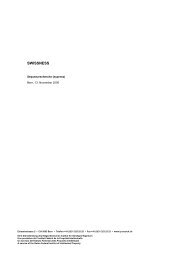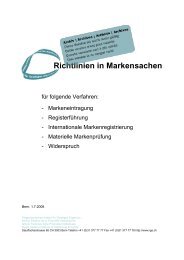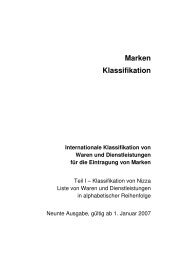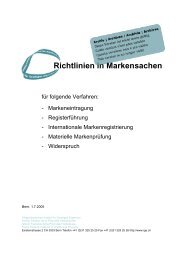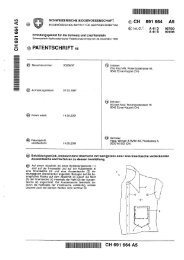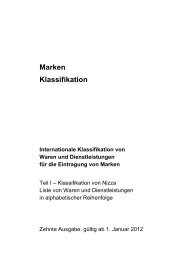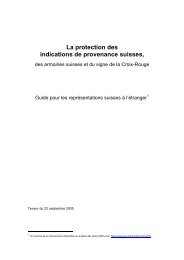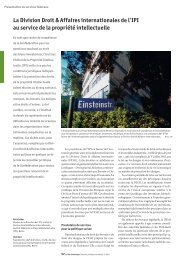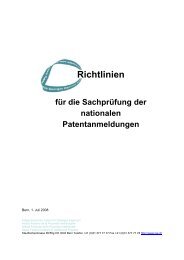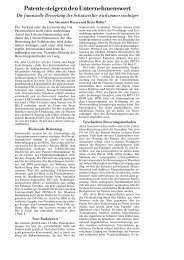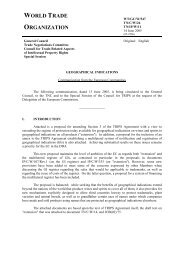AVIS DE DROIT PROTECTION DES SIGNES NATIONAUX
AVIS DE DROIT PROTECTION DES SIGNES NATIONAUX
AVIS DE DROIT PROTECTION DES SIGNES NATIONAUX
You also want an ePaper? Increase the reach of your titles
YUMPU automatically turns print PDFs into web optimized ePapers that Google loves.
d) Protection des signes nationaux<br />
(i) National Insignia Used as Trademarks<br />
AUSTRALIE<br />
Certain national insignia are protected against registration in Australia as trade marks. The<br />
range of such insignia that are expressly recognised by the current Trade Marks Act 1995 is<br />
much smaller than under the previous Trade Marks Act 1955. At present, express protection is<br />
given to the flags of States Parties to the Paris Convention and to state emblems notified<br />
under Art. 6ter, to the flags, arms and seals of the Commonwealth of Australia and of<br />
Australian States, Territories, municipalities, public authorities and public institutions and<br />
specifically to the word “Austrade”, being the trade name of the Australian federal export<br />
promotion authority; Trade Marks Regulations 1995, reg. 4.15 and schedule 2. It should be<br />
noted that the protection afforded is not absolute. Sec. 18 of the Trade Marks Act 1995<br />
permits the executive to make regulations prohibiting any and all use of specified insignia as<br />
trade marks, but no such regulations have been proclaimed. Reg. 4.15 and schedule 2 were<br />
instead expressly proclaimed under subpara. 39(2)(a) of the Act, which permits the executive<br />
to prescribe insignia that may be rejected as or as part of a proposed trade mark. No criteria<br />
are provided for the trade marks registry to decide whether or not to register a mark<br />
containing any of the specified insignia, but it may be supposed that registration would only<br />
be approved in cases where the appropriate permission had been obtained by the applicant.<br />
On the other hand, the trade marks registry is under a general duty to refuse to register trade<br />
marks which, in relation to the particular goods or services in respect of which they are<br />
proposed to be used, “would be likely to deceive or cause confusion”; Trade Marks Act 1995,<br />
sec. 43. The registry takes the view 405 that this will be the case where the mark as a whole or<br />
some element of it misrepresents the geographical origin of the relevant goods or services.<br />
Furthermore, it is possible for any interested party to oppose registration of a mark on the<br />
ground that it is intended to be used in respect of particular goods and that it contains a<br />
“geographical indication” referring to a country, region or locality other than the country,<br />
region or locality from which those goods really originate; Trade Marks Act 1995, sec. 61. A<br />
“geographical indication” is defined in sec. 6 as some kind of insignia recognised in the<br />
relevant country, region or locality as designating goods which originate from that country,<br />
region or locality, either on a purely geographical basis or by reference to the quality or other<br />
special characteristics of the relevant class of goods when produced or manufactured in that<br />
country, region or locality. Once an opposition is lodged, the applicant for registration has the<br />
onus of showing that he is using the geographical indication accurately, or that the<br />
geographical indication is no longer used in the relevant country, region or locality, or that he<br />
will not use the trade mark in such a manner as to deceive or confuse consumers as to the<br />
origins of the goods. Special provisions reflecting Australia’s obligations under the TRIPS<br />
Agreement govern marks for wines and spirits and a grandfather clause is available to<br />
applicants who can show that they were using the relevant geographical indications before the<br />
Act came into force or before they were recognised in the country from which the relevant<br />
goods originate.<br />
405 Refer to the Trade Marks Manual of Practice and Procedure, Part 29, para. 1.4.<br />
228



